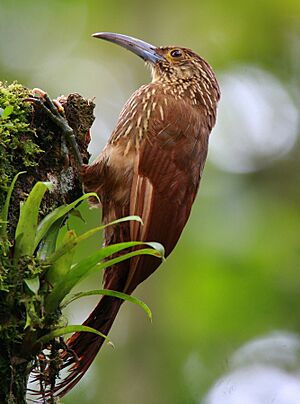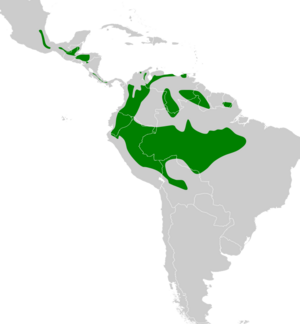Strong-billed woodcreeper facts for kids
Quick facts for kids Strong-billed woodcreeper |
|
|---|---|
 |
|
| Conservation status | |
| Scientific classification | |
| Genus: |
Xiphocolaptes
|
| Species: |
promeropirhynchus
|
 |
|
The strong-billed woodcreeper (Xiphocolaptes promeropirhynchus) is a type of bird found in many parts of Central and South America. It belongs to the ovenbird family called Furnariidae. This bird is known for its strong, thick bill, which helps it find food.
You can find the strong-billed woodcreeper in countries like Belize, Bolivia, Brazil, Colombia, Costa Rica, Ecuador, El Salvador, Guatemala, Guyana, Honduras, Mexico, Nicaragua, Panama, Peru, and Venezuela.
Contents
About the Strong-billed Woodcreeper
How Scientists Classify This Bird
Scientists group living things using a system called taxonomy. This helps them understand how different species are related. For the strong-billed woodcreeper, its classification is still being studied.
There are many different types, or subspecies, of the strong-billed woodcreeper. Scientists are still working to agree on the exact number and how they are all related. This shows that nature is full of amazing variety!
What the Strong-billed Woodcreeper Looks Like
The strong-billed woodcreeper is one of the biggest birds in its family. It is also the heaviest of the woodcreepers. These birds are about 28 to 31.5 cm (11 to 12 in) long. They weigh between 103 and 144 g (3.6 and 5.1 oz). Both male and female birds look very similar.
They have a dark brown head and neck with light streaks. Their back and wings are brown, and their lower back and tail are a reddish-brown color. Their throat is a plain, light buff color. Their chest and belly are brownish with narrow, light streaks and some small dark spots.
Their most noticeable feature is their long, strong, and slightly curved bill. It can be gray or black. Their eyes are dark brown, amber, or red, and their legs and feet are bluish-gray or greenish-black. Young birds are usually a bit darker than adults. Different subspecies might have slight differences in their size, color, or markings.
Where the Strong-billed Woodcreeper Lives
The strong-billed woodcreeper lives in a huge area across Central and South America. It prefers many types of forests, including primary forest (old, untouched forests) and mature secondary forest (forests that have grown back). It usually avoids areas where forests are broken up or very young.
In Central America, it lives in montane forests, which are forests found in mountains. These often have oak and pine trees. In the Amazon Basin, it lives in humid forests. In the Andes mountains, it lives in humid evergreen forests and cloudforests, which are forests often covered in clouds.
These birds can be found from sea level all the way up to 3,500 m (11,500 ft) high in the mountains. Their exact elevation depends on the region. For example, in Mexico, they are usually found between 1,500 and 3,500 m (4,900 and 11,500 ft).
Strong-billed Woodcreeper Behavior
Movement
The strong-billed woodcreeper does not migrate. It stays in the same area all year round.
Feeding Habits
This bird mainly eats arthropods, which are creatures like insects and spiders. Sometimes, it also eats small animals with backbones. The strong-billed woodcreeper is known to follow army ant swarms. These ants stir up other insects as they move, making it easy for the woodcreeper to catch them on the ground or on low tree trunks.
When not following ants, it looks for food higher up in the trees. It climbs up tree trunks and along branches, poking into leaves, bark, dead wood, and plants like bromeliads. It usually searches for food alone or in pairs.
Reproduction and Life Cycle
Strong-billed woodcreepers seem to form pairs that stay together. Both parents help build the nest and take care of their young. The time of year when they nest can be different depending on where they live. For example, in some northern areas, they nest from March to May, while in Brazil, they might nest in October.
Scientists have only found a few nests. These nests were in special nest boxes and were lined with leaves. The birds usually lay two or three eggs. The young birds leave the nest about three to four weeks after they hatch.
Vocalization (Sounds)
The strong-billed woodcreeper sings mostly in the early morning and late evening. Its songs can sound different depending on where the bird lives. Generally, it makes a long, ringing, descending series of whistles.
For example, in northern Central America, it makes a thin, rising teeeeuuuuuWEEEK! sound that gets quieter. In Costa Rica, it might repeat a loud KEW-WEE about 10 times. In Ecuador, its song is a series of paired notes like 'pt-teeu, pt-teeu'.
Scientists are still studying all the different sounds these birds make across their wide range.
Conservation Status
The IUCN (International Union for Conservation of Nature) has listed the strong-billed woodcreeper as a species of Least Concern. This means it is not currently in immediate danger of disappearing. It lives across a very large area, and its population is estimated to be between 50,000 and 500,000 adult birds.
However, the number of strong-billed woodcreepers is thought to be going down. The biggest threat to this bird is the loss of its forest home. This happens because of logging, clearing land for farming, raising livestock, and building cities. Protecting these forests is important for the future of the strong-billed woodcreeper.


